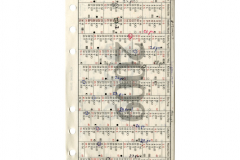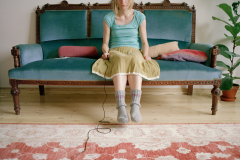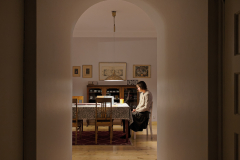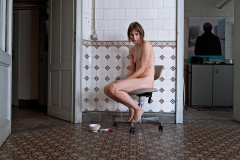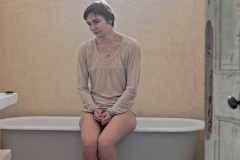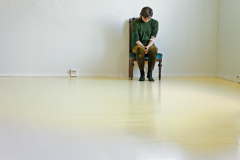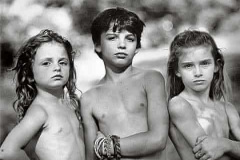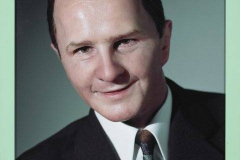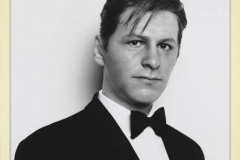Exercise 1: Brotherus Research and Analysis
Reflect on the pieces of work discussed in this project in your learning log and do some further research of your own. Here are a few questions you might ask yourself:
How do these images make you feel?
Do you think there’s an element of narcissism or self-indulgence in focusing on your own identity in this way?
What’s the significance of Brotherus’s nakedness?
Can such images ‘work’ for an outsider without accompanying text?
Do you think any of these artists are also addressing wider issues beyond the purely personal?
Elina Brotherus works in photography and moving image. Her work has been alternating between autobiographical and art-historical approaches. Photographs dealing with the human figure and the landscape, the relation of the artist and the model, gave way to images on subjective experiences in her recent bodies of work Annonciation and Carpe Fucking Diem. (Elina Brotherus.com
Elina Brotherus
Having read the context behind Annonciation I tried to view the images in an empathetic frame of mind. I don’t have much experience of people who have gone through and failed with IVF.
In general, I was struck by the deep sorrow and emotions projected in the images. However, I did feel there were perhaps too many of them and this lessened the overall impact. The series also made me feel uncomfortable like I was intruding upon some personal moment(s). The image 09 is one of the strongest and holds up very well on its own, while others, notably 4,5,6 feel very staged (which they are!) and 14,17 and 23,27 have elements of unnecessary repetition.
I wouldn’t say that there is an element of self-indulgence or narcism in the approach , on the contrary, I’d say it was quite a brave thing to do but having the context definitely helps as I’m not sure one could fully get the series otherwise. Photography, sometimes helps deal with situations, for example Briony Campbell-The Dad Project 2009 explores her relationship with her father and his impending death. Both Campbell’s and Brotherus’s work explore and lay bare subjects that people sometimes struggle with or find taboo. They are both personal and addressing wider issues albeit from and insider point of view. Having the context helps when looking at the images and without accompanying text I think that gap between the text and image might be too big and open to an interpretation that strays away from the IVF narrative (in the case of Brotherus, as commented on above, some images work well on their own but having a context makes the series stronger and more impactful.
Sally Mann
To be able to take my pictures, I have to look, all the time, at the people and places I care about. And I must do so with both ardor and cool appraisal, with the passions of eye and heart, but in that ardent heart there must also be a splinter of ice.
—Sally Mann
Sally Mann is known for her photographs of intimate and familiar subjects rendered both sublime and disquieting. Her projects explore the complexities of familial relationships, social realities, and the passage of time, capturing tensions between nature, history, and memory ( https://gagosian.com/artists/sally-mann/ (accessed 23/02/2022)
Mann’s images and portraits of her family challenge the traditional style of family portraiture where they are often shot naked or suggest adult themes or children growing old before their time (Immediate Family)-this has sometimes attracted criticism prompting her to comment- ‘different eyes see different ways’. Some images stop you in their tracks and have a very distinctive style. Mann uses her images to explore different themes, like the complexities of familial relationships, social realities, and the passage of time. She shies away from the saccharine family type snaps and in an interview in the New York Times explained:
“I’m responding with the only vocabulary I have to ordinary and extraordinary situations that I see around me. I have to slap my hands sometimes not to take certain pictures. But the more I look at the life of the children, the more enigmatic and fraught with danger and loss their lives become. That’s what taking any picture is about. At some point, you just weigh the risks.”
Having used my own children for portraiture I can empathise with Mann’s point of view-her images make me feel uncomfortable at times but if I take her at her word -she has talked at length about how her children feel about her work- I also see an artist standing her creative ground and if it opens debates around topics from child pornography to exploitation, then so be it. her work is very personel and most of her images are constructed fictions rather than fact, a post-modernist approach more akin to Cindy Shermann and her use and mastery of large format camera coupled with her development and printing including ‘vignetting, shallow depth of field, blurred edges and general languor — connects her to neo-pictorialists like Bruce Weber and the Starns. Like them, she depends as much on evocation as description (https://www.nytimes.com/2015/04/19/magazine/the-disturbing-photography-of-sally-mann.html?searchResultPosition=4 accessed 06/03/2022).
Gillian Wearing
Gillian Wearing CBE, RA is an English conceptual artist, one of the Young British Artists, and winner of the 1997 Turner Prize. In 2007 Wearing was elected as lifetime member of the Royal Academy of Arts in London. Her statue of the suffragist Millicent Fawcett stands in London’s Parliament Square. Wikipedia
In her work ‘Album’ Wearing explores family dynamics and influence by using makeup, props, and silicone masks to disguise herself in the face of several of her relatives based on old snapshots. The series looks at the impact those close to us have on our psychological makeup. Once you know its Wearings eyes behind the mask, the photos take on a totally different meaning, forcing one to reflect on both our individuality and ‘genetic destiny’, making the images highly personal while also tackling wider issues like the role of family in who we are or become.
References
Sally Mann with Charlie Rose 2016 https://www.youtube.com/watch?v=u4jaRBwGVYc
https://gagosian.com/exhibitions/2008/sally-mann/
https://www.guggenheim.org/artwork/artist/gillian-wearing




